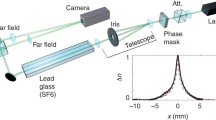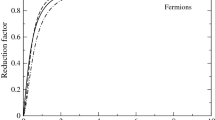Abstract
In this paper, we study the evolutions of a self-gravitating cloud of bosonic dark matter with finite angular momentum and self-interaction. This is achieved by using the sixth-order pseudospectral operator splitting method to solve the system of nonlinear Schrödinger and Poisson equations. The initial cloud is assumed to have mass density randomly distributed throughout three-dimensional space. The dark matter particles in the initial cloud are in the kinetic regime, i.e., their de Broglie wavelength is much smaller than the halo size.
It is shown that Bose stars are indeed formed in the numerical simulation presented here. The presence of angular momentum and self-interaction in the initial cloud can significantly influence the star formation time in a non-trivial fashion. For the cases when the self-interaction is negligible or attractive, our analysis indicates that the stars formed in such scenarios may not have any intrinsic angular momentum. Conversely, if the self-interaction is repulsive, it is possible to have an angular momentum transfer from the cloud to the star. The presented numerical results agree with the expectation based on analytical calculations related to the instability of a rotating boson star with self-interaction. Furthermore, it is shown that the average mass and radius diagrams of the star are strongly influenced by the presence of angular momentum in the initial cloud.












Similar content being viewed by others
References
Abbott, R., et al.: GW190521: a binary black hole merger with a total mass of \(150 M_{\odot}\). Phys. Rev. Lett. 125(10), 101102 (2020). https://doi.org/10.1103/PhysRevLett.125.101102. arXiv:2009.01075 [gr-qc]
Buckley, J.H., Dev, P.S.B., Ferrer, F., et al.: Fast radio bursts from axion stars moving through pulsar magnetospheres. Phys. Rev. D 103, 043015 (2021). https://doi.org/10.1103/PhysRevD.103.043015, https://link.aps.org/doi/10.1103/PhysRevD.103.043015
Bustillo, J.C., Sanchis-Gual, N., Torres-Forné, A., et al.: Gw190521 as a merger of proca stars: a potential new vector boson of \(8.7\times {10}^{- 13}\text{ eV}\). Phys. Rev. Lett. 126, 081101 (2021). https://doi.org/10.1103/PhysRevLett.126.081101, https://link.aps.org/doi/10.1103/PhysRevLett.126.081101
Chavanis, P.H.: Mass-radius relation of Newtonian self-gravitating Bose-Einstein condensates with short-range interactions. I. analytical results. Phys. Rev. D 84, 043531 (2011). https://doi.org/10.1103/PhysRevD.84.043531, https://link.aps.org/doi/10.1103/PhysRevD.84.043531
Chen, J., Du, X., Lentz, E.W., et al.: New insights into the formation and growth of boson stars in dark matter halos. Phys. Rev. D 104, 083022 (2021). https://doi.org/10.1103/PhysRevD.104.083022, https://link.aps.org/doi/10.1103/PhysRevD.104.083022
Chen, J., Du, X., Lentz, E.W., et al.: Relaxation times for Bose-Einstein condensation by self-interaction and gravity. Phys. Rev. D 106, 023009 (2022). https://doi.org/10.1103/PhysRevD.106.023009, https://link.aps.org/doi/10.1103/PhysRevD.106.023009
Dmitriev, A.S., Levkov, D.G., Panin, A.G., et al.: Instability of rotating Bose stars. Phys. Rev. D 104, 023504 (2021). https://doi.org/10.1103/PhysRevD.104.023504, https://link.aps.org/doi/10.1103/PhysRevD.104.023504
Eby, J., Kouvaris, C., Nielsen, N.G., et al.: Boson stars from self-interacting dark matter. J. High Energy Phys. 02, 028 (2016). https://doi.org/10.1007/JHEP02(2016)028. arXiv:1511.04474 [hep-ph]
Hogan, C.J., Rees, M.J.: Axion miniclusters. Phys. Lett. B 205, 228–230 (1988). https://doi.org/10.1016/0370-2693(88)91655-3
Hu, W., Barkana, R., Gruzinov, A.: Fuzzy cold dark matter: the wave properties of ultralight particles. Phys. Rev. Lett. 85, 1158–1161 (2000). https://doi.org/10.1103/PhysRevLett.85.1158, https://link.aps.org/doi/10.1103/PhysRevLett.85.1158
Kaup, D.J.: Klein-Gordon geon. Phys. Rev. 172, 1331–1342 (1968). https://doi.org/10.1103/PhysRev.172.1331, https://link.aps.org/doi/10.1103/PhysRev.172.1331
Kolb, E.W., Tkachev, I.I.: Axion miniclusters and Bose stars. Phys. Rev. Lett. 71, 3051–3054 (1993). https://doi.org/10.1103/PhysRevLett.71.3051, https://link.aps.org/doi/10.1103/PhysRevLett.71.3051
Larson, R.B.: Gravitational torques and star formation. Mon. Not. R. Astron. Soc. 206, 197–207 (1984). https://doi.org/10.1093/mnras/206.1.197
Levkov, D.G., Panin, A.G., Tkachev, I.I.: Relativistic axions from collapsing Bose stars. Phys. Rev. Lett. 118, 011301 (2017). https://doi.org/10.1103/PhysRevLett.118.011301, https://link.aps.org/doi/10.1103/PhysRevLett.118.011301
Levkov, D.G., Panin, A.G., Tkachev, I.I.: Gravitational Bose-Einstein condensation in the kinetic regime. Phys. Rev. Lett. 121, 151301 (2018). https://doi.org/10.1103/PhysRevLett.121.151301, https://link.aps.org/doi/10.1103/PhysRevLett.121.151301
Preskill, J., Wise, M.B., Wilczek, F.: Cosmology of the invisible axion. Phys. Lett. B 120(1), 127–132 (1983). https://doi.org/10.1016/0370-2693(83)90637-8. https://www.sciencedirect.com/science/article/pii/0370269383906378
Pshirkov, M.S.: May axion clusters be sources of fast radio bursts? Int. J. Mod. Phys. D 26(07), 1750068 (2017). https://doi.org/10.1142/S0218271817500687. arXiv:1609.09658 [astro-ph.HE]
Raby, S.: Axion star collisions with neutron stars and fast radio bursts. Phys. Rev. D 94(10), 103004 (2016). https://doi.org/10.1103/PhysRevD.94.103004. arXiv:1609.01694 [hep-ph]
Ruffini, R., Bonaola, S.: Systems of self-gravitating particles in general relativity and the concept of an equation of state. Phys. Rev. 187, 1767–1783 (1969). https://doi.org/10.1103/PhysRev.187.1767, https://link.aps.org/doi/10.1103/PhysRev.187.1767
Sanchis-Gual, N., Di Giovanni, F., Zilhão, M., et al.: Nonlinear dynamics of spinning bosonic stars: formation and stability. Phys. Rev. Lett. 123, 221101 (2019). https://doi.org/10.1103/PhysRevLett.123.221101, https://link.aps.org/doi/10.1103/PhysRevLett.123.221101
Savitzky, A., Golay, M.J.E.: Smoothing and differentiation of data by simplified least squares procedures. Anal. Chem. 36, 1627–1639 (1964). https://doi.org/10.1021/ac60214a047
Schiappacasse, E.D., Hertzberg, M.P.: Analysis of dark matter axion clumps with spherical symmetry. J. Cosmol. Astropart. Phys. 01, 037 (2018). https://doi.org/10.1088/1475-7516/2018/01/037, [Erratum: JCAP 03, E01 (2018)], arXiv:1710.04729 [hep-ph]
Schwabe, B., Gosenca, M., Behrens, C., et al.: Simulating mixed fuzzy and cold dark matter. Phys. Rev. D 102, 083518 (2020). https://doi.org/10.1103/PhysRevD.102.083518, https://link.aps.org/doi/10.1103/PhysRevD.102.083518
Seigar, M.S.: The connection between shear and star formation in spiral galaxies. Mon. Not. R. Astron. Soc. Lett. 361(1), L20–L24 (2005). https://doi.org/10.1111/j.1745-3933.2005.00056.x, https://academic.oup.com/mnrasl/article-pdf/361/1/L20/2995591/361-1-L20.pdf
Siemonsen, N., East, W.E.: Stability of rotating scalar boson stars with nonlinear interactions. Phys. Rev. D 103, 044022 (2021). https://doi.org/10.1103/PhysRevD.103.044022, https://link.aps.org/doi/10.1103/PhysRevD.103.044022
Turk, M.J., Smith, B.D., Oishi, J.S., et al.: yt: a multi-code analysis toolkit for astrophysical simulation data. Astrophys. J. Suppl. Ser. 192(1), 9 (2010). https://doi.org/10.1088/0067-0049/192/1/9
Turner, M.S.: Cosmic and local mass density of “invisible” axions. Phys. Rev. D 33, 889–896 (1986). https://doi.org/10.1103/PhysRevD.33.889, https://link.aps.org/doi/10.1103/PhysRevD.33.889
Veltmaat, J., Niemeyer, J.C., Schwabe, B.: Formation and structure of ultralight bosonic dark matter halos. Phys. Rev. D 98, 043509 (2018). https://doi.org/10.1103/PhysRevD.98.043509, https://link.aps.org/doi/10.1103/PhysRevD.98.043509
Visinelli, L.: Boson stars and oscillatons: a review. Int. J. Mod. Phys. D 30(15), 2130006 (2021). https://doi.org/10.1142/S0218271821300068. arXiv:2109.05481 [gr-qc]
Weinberg, S.: Gravitation and Cosmology: Principles and Applications of the General Theory of Relativity. Wiley, New York (1972)
Wheeler, J.A.: Geons. Phys. Rev. 97, 511–536 (1955). https://doi.org/10.1103/PhysRev.97.511, https://link.aps.org/doi/10.1103/PhysRev.97.511
Acknowledgements
We are grateful to Bodo Schwabe, Mateja Gosenca, and Dilip Angom for helpful discussions and for their assistance with the publicly available code AxioNyx. We also extend our appreciation to the anonymous referee for their constructive comments that significantly improved the quality of this research paper. All the computations were accomplished on the Vikram-100 and Vikram-1000 HPC cluster at the Physical Research Laboratory, Ahmedabad.
Author information
Authors and Affiliations
Contributions
Kuldeep J. Purohit and Pravin Kumar Natwariya did the numerical simulations and prepared the figures. Jitesh R. Bhatt, Kuldeep J. Purohit and Prashant K. Mehta wrote the main manuscript text. All authors reviewed the manuscript.
Corresponding author
Ethics declarations
Competing interests
The authors declare no competing interests.
Additional information
Publisher’s Note
Springer Nature remains neutral with regard to jurisdictional claims in published maps and institutional affiliations.
Rights and permissions
Springer Nature or its licensor (e.g. a society or other partner) holds exclusive rights to this article under a publishing agreement with the author(s) or other rightsholder(s); author self-archiving of the accepted manuscript version of this article is solely governed by the terms of such publishing agreement and applicable law.
About this article
Cite this article
Purohit, K.J., Natwariya, P.K., Bhatt, J.R. et al. Formation of a Bose star in a rotating cloud. Astrophys Space Sci 368, 97 (2023). https://doi.org/10.1007/s10509-023-04253-8
Received:
Accepted:
Published:
DOI: https://doi.org/10.1007/s10509-023-04253-8




